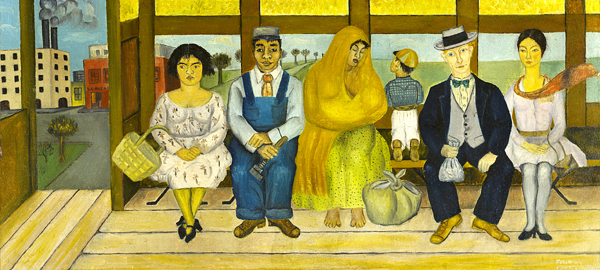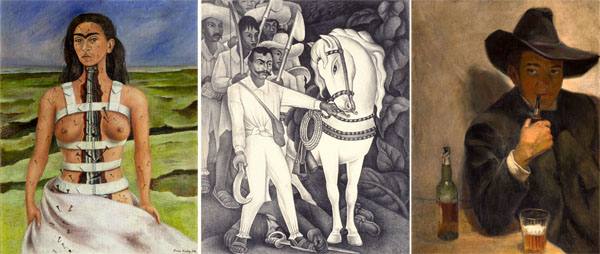Exhibit traces two artists’ overlapping lives

“The Bus” (1929) depicts the moment before Frida Kahlo was involved in a serious auto accident. She suffered from pain for the rest of her life.
However, even though they shared a love for Mexico and its people, the relationship between the couple resulted in pain, especially for Kahlo.
A special summer exhibition of Kahlo and Rivera’s art is currently being held at the Hangaram Design Museum of the Seoul Arts Center in Seocho District, southern Seoul.
The Dolores Olmedo Museum in Mexico City is participating in the exhibition by contributing part of its collection. A total of 150 pieces are on display including paintings, drawings, photographs and several pieces of Kahlo’s attire.
The exhibition is divided into four sections. The very first section focuses on Rivera’s works, which trace his life as an artist.
The next section centers on the works of Kahlo, reflecting her feelings of love, sorrow, loss and pain.
The other two sections feature excerpts from Kahlo’s diaries, photographs, and video clips of the two artists.
The correlation between the couple and Mexico as shown through their art is a major feature of the exhibition. It shows how their lives in Mexico represent the modern history of the country and its people.
“Through the art works of Kahlo and Rivera, the visitors will be able to understand the culture, history and the transformation of industry of Mexico,” said Carlos Phillips Olmedo, the director of the Dolores Olmedo Museum. “It is connected to the period when the relationship between Kahlo and Rivera was built, which was after the Mexican Revolution [1910-20].”
“They both had passion as Mexican artists, which was the core factor in making solidarity in the relationship,” Olmedo added.
It was Rivera who noticed Kahlo’s artistic ability and encouraged her to keep painting.
However, as a married couple, their affection was challenged by Rivera’s constant extramarital affairs. This greatly affected Kahlo and her works.
Rivera is remembered as a central artist of Mexico who mainly created murals. His works signify the soul of the people. He showed reverence toward the revolution in such works as “The Agrarian Leader Zapata” (1932), the last of a series of three lithographs that symbolize the downfall of the dictator. Thus, his works are strongly associated with the history of Mexico.
On the other hand, Kahlo focused more on her own character. Almost half of her paintings are self-portraits.
After she was involved in a serious bus accident in 1927, she had to live in pain until her death. In her work “The Bus” (1929), she recollects the hour just before the accident. It is a unique work that is closely connected to her pain of an accident.

Left: “The Broken Column” (1944) is a self-portrait of Kahlo showing her strong will to live. Center: “The Agrarian Leader Zapata” (1932) by Diego Rivera shows the downfall of the authoritarian leader. Right: “Self-Portrait with Broad-Brimmed Hat” (1907) shows Rivera in a Spanish atmosphere. [SEOUL ARTS CENTER]
Kahlo wrote that her paintings contain the pain that filled her life. Also, while she lost three babies, her paintings gave them back to her.
Her firm will to live is manifested well in her famous work “The Broken Column” (1944).
“The spine is portrayed in metal, which shows her strength as the surviving one,” Olmedo explained. “You can see the nails penetrating her body with blood, and she sheds tears but she stands up straight. That is Frida Kahlo.”
Kahlo is widely acknowledged as a pioneering feminist in Mexico. She was a freewheeling person who tried to bypass the limitations women faced in society. Despite her death in 1954, the feminist movement spread in the 1960s.
Rivera once said that Kahlo is an artist who paints woman’s senses and anguish in a poetic style. She is one of the foremost artists of the Mexican renaissance.
Along with her art, visitors to the exhibition can understand Kahlo as a person.
“It is different from the previous exhibition held in 2015 at Seoul Olympic Museum of Art,” said Tae Seung-jin, the Seoul Arts Center’s general director of art management. “The art works being exhibited now are more closely related to the lives of both Kahlo and Rivera.”
“It will provide an opportunity for visitors to learn more about their lives,” Tae added. “Also it will be interesting to compare and contrast each of their works.”
**The exhibition runs through Aug. 28. The museum is closed every last Monday of the month. Admission for adults costs 15,000 won ($13). On weekdays beginning at 1, 3 and 5 p.m., a docent will give a guided tour. For further details, visit www.sac.or.kr.
BY KIM HYANG-MIN [kim.hyangmin@joongang.co.kr]










with the Korea JoongAng Daily
To write comments, please log in to one of the accounts.
Standards Board Policy (0/250자)